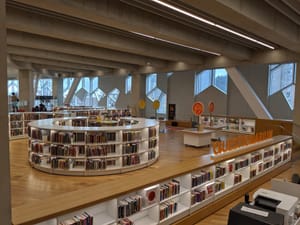The National Library of Australia has made an interesting report available, National Library of Australia IT Architecture Project Report, March 2007. [pdf] Here is the declared purpose:
The aim of this report is to define the IT architecture that will be needed to support the management, discovery and delivery of the National Library of Australia’s collections over the next three years. The current architecture has allowed the library to develop a significant digital library capability over the last decade. Now the burden of maintaining and supporting existing systems and services is increasingly hindering us from bringing new services online, improving the user experience, exploring new ideas or responding to technological change. In the meantime, enormous changes are occurring in the broader environment.
The report identifies three major responses within the context of a new framework for digital library services (I talk about them in a different order than the one in which they are presented). One, it recommends a move to a service-oriented architecture. The grounds for this are clear, and clearly made in the report. They include the ability to share common services across applications, to be able to respond to change effectively, and to reduce over time the redundancy, cost and complexity of development.
Two, it argues for using open source solutions where they are ‘functional and robust’. It notes an amendment to prior policy which favored a buy over a build policy. The Library will now consider open source solutions based on function and cost comparisons. The assessment of cost will not only include consideration of the direct costs of additional development but also the benefits of contributing code to the community and, interestingly, the opportunity costs of using commercial software whose development path is not aligned with library direction and need. The report notes the possibility of collaboratively sourcing some functionality with partners.
And three, the report talks about a ‘single business’ approach. This was the most interesting aspect of the document to me, because it underscores a major issue for libraries and the systems they deploy. This is that applications have developed in a piecemeal fashion over recent years, so that library operations are now supported by many applications, in different stages of maturity, and with different levels of process standardization. However, this ensemble of applications does not support efficient working across the range of library requirements, and inhibits flexible service development. Indeed, boundaries between these applications seem increasingly arbitrary, and to owe more to historic circumstance, and to the structure of the industry that has developed over time, than to current needs. Simply managing this diversity is a major task in itself. The ERAMS (electronic resource access and management services) discussion I mentioned a while ago is one symptom of a growing sense that the library systems landscape needs to be redefined.
The ‘single business’ approach is a recommendation that the library think in terms of a single ‘business’ and a single data corpus as part of its planning process, rather than in terms of separate planning for each service line or resource type (e.g. images, books, music). And that technical solutions be designed in ways that minimize the number of separate business applications that need to be developed. Of course, the service-oriented approach would facilitate the latter goal. In practice this would mean trying to streamline workflow across management environments for different resource types; using common delivery, rights management and other solutions; and developing a single integrated discovery environment across collections and resource types, which can be accessed through different views.
The report is well structured, and is worth reading as much as for its discussion of some general issues as it is for the particular National Library of Australia situation. .



